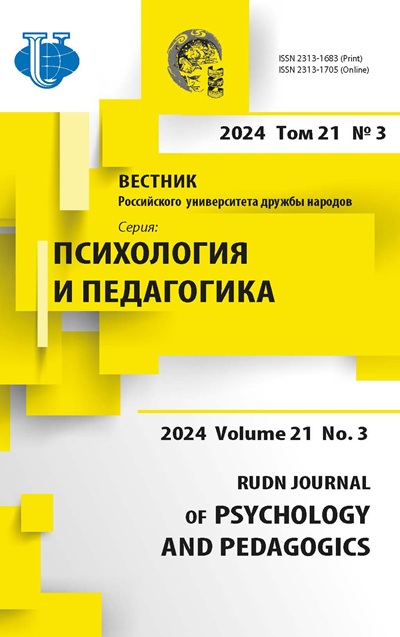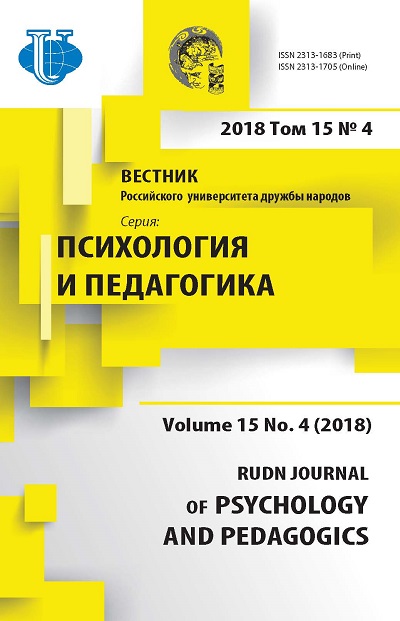Social Activity of Personality and Groups: Definition, Structure and Mechanisms
- Authors: Shamionov R.M1
-
Affiliations:
- Saratov State University
- Issue: Vol 15, No 4 (2018)
- Pages: 379-394
- Section: PERSONALITY AND SOCIAL PSYCHOLOGY
- URL: https://journals.rudn.ru/psychology-pedagogics/article/view/20369
- DOI: https://doi.org/10.22363/2313-1683-2018-15-4-379-394
Cite item
Full Text
Abstract
The problem of social activity of the personality and groups becomes central in modern social, economic and political psychology. The innovative processes in the society, maintaining a dynamic balance in it, entirely depend on the release of the social activity of the individuals and groups, on its freedom and diversity, constructiveness and responsibility. The article presents a theoretical analysis of the problem of operationalization of the phenomena of social activity of the individual and groups, the synthesis of the disparate data on its foundations, motivators, mechanisms and social effects. The definition of social activity as a special case of initiative impact of social actors on the social environment, as the actions aimed at changing and transforming social objects as a result of which there is a change in the personality and the entire social situation, the problem of its operationalization is discussed. It is shown that social activity is the effect of socialization and development of the individual. The differences of social activity in different age periods and its importance for the individual and its sociopsychological status are singled out. The multi-component structure of the social activity, including the cognitive, emotionally-evaluative, motivational, and behavioral components are highlighted. The incentive mechanisms of social activity (motivation, satisfaction/dissatisfaction as an indicator of diachronic mismatch of personality and the social environment) are analyzed. The empirical research aimed at finding out the predictors and basis of the dominant types of social activity of the individual is outlined.
About the authors
Rail M Shamionov
Saratov State University
Author for correspondence.
Email: shamionov@mail.ru
Doctor Sc. of Psychology, Professor, Head of the Chair of Social Psychology of Education and Development, Saratov State University (Saratov, Russia).
83 Astrakhanskaya St., Saratov, 410012, Russian FederationReferences
- Balabanov, S.S., & Kukonkov, P.I. (2013). The metamorphosis of social activity in the reformed Russia. Vestnik of Lobachevsky State University of Nizhni Novgorod. Series: Social Sciences, 1(29), 12—16. (In Russ.)
- Bocharova, E.E. (2012). Relationship between Subjective Well-Being and Social Activity: Cross-Cultural Aspect. Social Psychology and Society, (4), 53—63. (In Russ.)
- Brown, C.L., Gibbons, L.E., Kennison, R.F., Robitaille, A., Lindwall, M., Mitchell, M.B., Shirk, S.D., Atri, A., Cimino, C.R., Benitez, A., MacDonald, S.W.S., Zelinski, E.M., Willis, S.L., Schaie Warner, K., Johansson, B., Dixon, R.A., Mungas, D.M., Hofer, S.M., & Piccinin, A.M. (2012). Social Activity and Cognitive Functioning Over Time: A Coordinated Analysis of Four Longitudinal Studies. Journal of Aging Research, (l). Article ID 287438, 12 p. doi. org/10.1155/2012/287438
- Grigoryev, A.V. (2012). Motivation Social Activity of Youth. Izv. Saratov Univ. (N. S.). Ser. Philosophy. Psychology. Pedagogy, 12(3), 66—69. (In Russ.)
- Guseinov, A.Sh. (2016). Psychological background of genesis and maintenance of extremist worldview of youth. Каzan Pedagogical Journal, 3(116), 120—127. (In Russ.)
- Drobysheva, T.V. (2010). Tematicheskaya sektsiya “Sotsial’noe samoopredelenie i sotsial’naya aktivnost’ molodezhi”. Psikhologicheskii Zhurnal, 31(5), 115–117. (In Russ.)
- Dubov, I.G. (2010). Contents of the “action” category in Russian psychology. Social Psychology and Society, (1), 40—61. (In Russ.)
- Dubov, I.G. (2012). Sotsial’no-psikhologicheskie aspekty aktivnosti. Moscow; Saint Petersburg: NestorIstoriya Publ. 536 p. (In Russ.)
- Ilin, E.P. (2008). Motivatsiya i motivy. Saint Petersburg: Piter Publ. 512 p. (In Russ.)
- Kravchenko, S.А. (2004). Sotsiologicheskii ehntsiklopedicheskii russko-angliiskii slovar (pp. 20—21). Moscow: АST Publ. 501 p.
- Krupnov, A.I. (2006). The system-dispositional approach to studying the personality and its properties. RUDN Journal of Psychology and Pedagogics, (1), 63—73. (In Russ.)
- Krysko, V.G. (2001). Sotsial’naya psikhologiya: slovar’-spravochnik. Minsk: Kharvest. 688 p. (In Russ.)
- Kupreichenko, A.B. (2012). Problema opredeleniya i otsenki sotsial’noi aktivnosti. Psikhologiya individual’nosti. Conference Proceedings (pp. 181—182). Moscow: Logos Publ. (In Russ.)
- Kupreichenko, A.B., & Moiseev A.S. (2010). Vzaimosvyaz’ sotsial’nykh tsennostei i strategii kak elementov sotsial’nogo samoopredeleniya. Conference Proceedings (pp. 332—333). Moscow: Obshcherossiiskaya obshchestvennaya organizatsiya “Federatsiya psikhologov obrazovaniya Rossii”. (In Russ.)
- Leontev, V.G. (2004). Psikhologicheskie istochniki aktivnosti lichnosti. In V.G. Leontev (Ed.).
- Psikhologicheskie istochniki aktivnosti lichnosti (pp. 3—11). Novosibirsk: NGPU Publ. (In Russ.)
- McFarland, D.A., & Thomas, R.J. (2016). Bowling Young: How Youth Voluntary Associations Influence Adult Political Participation. American Sociological Review, 71(3), 401—425.
- Moiseev, A.S. (2013). Psikhologicheskii podkhod k opredeleniyu ponyatiya “sotsial’naya aktivnost’”. In Kovtunovich M.G. (Ed.). Sotsial’no-ekonomicheskie i psikhologicheskie problemy upravleniya, (1). Moscow: MGPPU. Available at: http://psyjournals.ru/social_economical_psychological_/ issue/63212.shtml (accessed: 8 August 2018). (In Russ.)
- Mikhailova, E.V., & Skogorev A.P. (2017). Protest as form of civil activity in modern Russia. Vlast’, 25(1), 54—59. (In Russ.)
- Novikov, V.V. (1998). Sotsial’naya psikhologiya: fenomen i nauka. Moscow: Institut psikhologii RAN Publ. 464 p. (In Russ.)
- Oosterhoff, B., Ferris, K.A., & Metzger, A. (2017). Adolescents’ Sociopolitical Values in the Context of Organized Activity Involvement. Youth & Society, 49(7), 947—967.
- Palatkina, G.V., & Azizova L.V. (2012). Structural components of the students social activity. Theory and practice of social development, (7), 85—87. (In Russ.)
- Petukhov, V.V. (2016). Crisis and protection of the citizens’ labour rights. Sociological Studies, 11 (390), 86—96. (In Russ.)
- Rubinshtein, S.L. (2006). Chelovek i mir. Saint Petersburg: Piter Publ. 512 p. (In Russ.)
- Rusalov, V.M. (2012). Temperament v strukture individual’nosti cheloveka: differentsial’nopsikhofiziologicheskie i psikhologicheskie issledovaniya. Moscow: Institut psikhologii RAN Publ. 528 p. (In Russ.)
- Sergienko, E.A. (2008). Razvitie idei psikhologii sub”ekta A.V. Brushlinskogo: sistemno-sub”ektnyi podkhod. In A.L. Zhuravlev, V.V. Znakov, Z.I. Ryabikina (Eds.). Lichnost’ i bytie: sub”ektnye podkhod (pp. 54—58) Moscow: Institut psikhologii RAN Publ. (In Russ.)
- Sokolova, E.S. (2011). Social Activity of Contemporary Russian Youth. Znanie. Ponimanie. Umenie, (1), 197—202. (In Russ.)
- Sokolova, E.S. (2008). Strukturnyi podkhod k ponimaniyu motivatsii sotsial’noi aktivnosti molodezhi. Znanie. Ponimanie. Umenie, (2), 18. Available at: http://www.zpu-journal.ru/e-zpu/2008/2/ Sokolova/ (accessed: 8 July 2018). (In Russ.)
- Sokhadze, K.G. (2017). Social activity of the Russian youth: the scope and restraining factors. RUDN Journal of Sociology, 17(3), 348—363. (In Russ.)
- Trotsuk, I.V., & Sokhadze, K.G. (2014). Social activity of the youth: approaches to the assessment of forms, motives and factors in the contemporary Russian society. RUDN Journal of Sociology, (4), 58—73. (In Russ.)
- Chernyshev, A.S., & Sarychev S.V. (2011). Sektsiya “Sotsial’noe samoopredelenie i sotsial’naya aktivnost’: psikhologicheskie problemy molodezhnoi politiki”. Psikhologicheskii Zhurnal, 32(5), 112—113. (In Russ.)
- Suslova, T.F. (2017). Sotsial’naya aktivnost’ lichnosti kak determinanta pozitivnoi adaptatsii i polnotsennoi zhizni v pensionnom vozraste. Sovremennaya zarubezhnaya psikhologiya, 6(3), 63— 70. doi: 10.17759/jmfp.2017060307 (In Russ.)
- Shamionov, R.M. (2012). Psikhologicheskie kharakteristiki sotsial’noi aktivnosti lichnosti. Mir psikhologii, (3), 145—154. (In Russ.)
- Shamionov, R.M., & Grigoryeva, M.V. (2012). Psikhologiya sotsial’noi aktivnosti molodezhi: problemy i riski. Saratov: Saratov State University Publ. 384 p. (In Russ.)
- Shiratuddin, N., Hassan, S., Mohd Sani, M.A., Ahmad, M.K., Khalid, K.A., Abdull Rahman, N.L., & Ahmad, N.S.Y. (2017). Media and youth participation in social and political activities: Development of a survey instrument and its critical findings. Pertanika Journal of Social Sciences and Humanities, 25, 1—19.
- Zhuravlev, A.L. (2009). Collective subject main features, levels and psychological types. Psikhologicheskii Zhurnal, 30(5), 72—80. (In Russ.)
- Zaitseva, M.A. (2008). Osnovnye napravleniya izucheniya problemy formirovaniya sotsial’noi aktivnosti uchashchikhsya v pedagogicheskoi teorii vo vtoroi polovine XX veka. Pedagogika, 1(54), 8—13. (In Russ.)
















